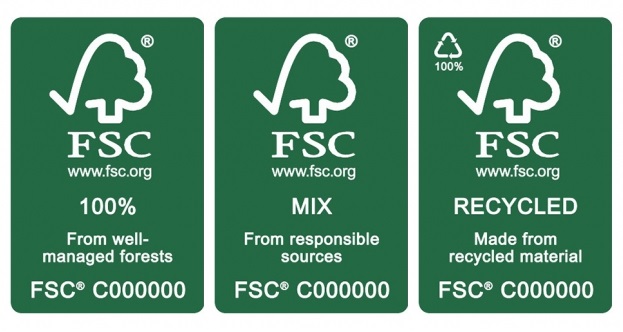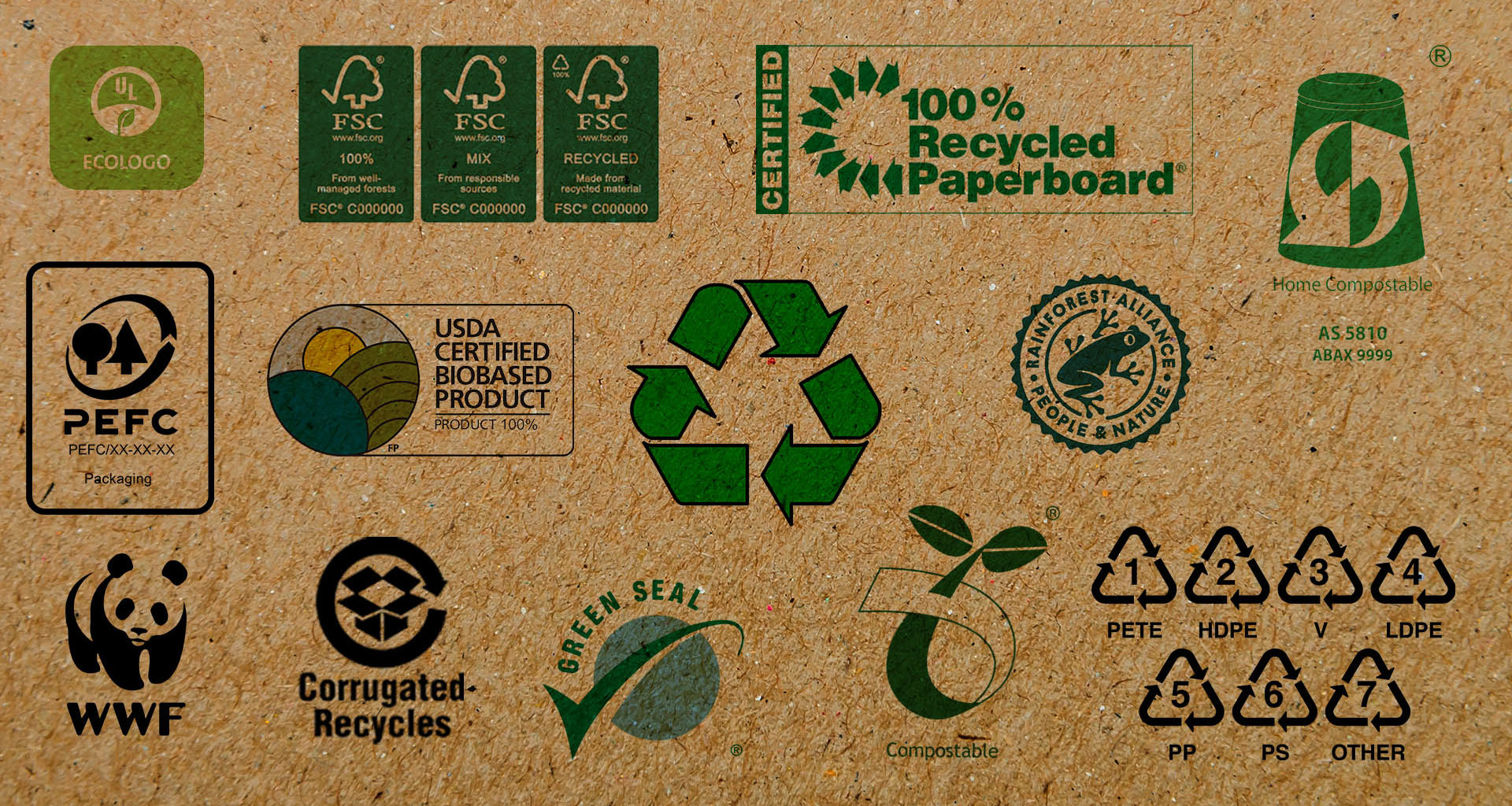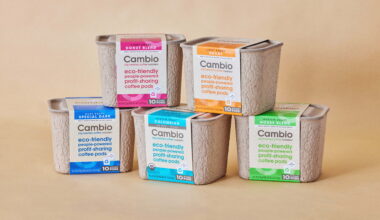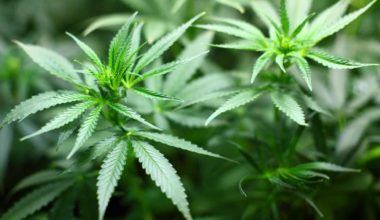As eco-friendly materials continue growing in popularity, packaging seems to be running out of labeling real estate. Many consumers have embarked on an environmentally conscious journey, starting with simple choices at the store. Head down the aisle and you’ll notice boxes printed with any number of symbols, from chasing arrows and mysterious acronyms to little frogs and pandas.
While you might be familiar with some of these logos, interpreting the back of a box can be downright confusing. Don’t worry, we’ve got you covered. Drawing from our experience as a sustainable packaging design agency, we compiled a list of these common symbols, complete with some helpful history and information.
*Skip ahead to our Recycling Symbols Cheat Sheet.*
Recycling Symbols
It all started with the chasing arrows. This simple, universal symbol has been reduced, reused, and recycled into many innovative and ambiguous forms.
Universal Recycling Symbol

Materials with this symbol can be recycled, depending on local programs.
Perhaps one of the most recognizable icons in the world, the recycling symbol was the winning design in a contest sponsored by a paperboard company in the early 1970s. Gary Anderson was just 23 years-old when he submitted his design, which is now an untrademarked symbol included in the public domain. Heck, it’s even an emoji.
The mobius loop has become the starting point for thousands of official (and unofficial) recycling symbol designs. But like any other piece of effective design, beware of deceptive application. Companies tend to slap the symbol on any piece of paper, plastic, or metal, whether or not the material is actually recyclable in your local curbside program.
Corrugated Recycles

This symbol indicates that the packaging is made from corrugated fiberboard and is readily recyclable. Corrugated fiberboard is a paper pulp containerboard composed of a fluted or ridged medium sandwiched between two layers of liner. You might know it as cardboard.
The symbol was introduced by the Corrugated Packaging Alliance and Fibre Box Association, non-profit trade associations representing North American corrugated packaging manufacturers. These manufacturers can print the standard symbol on their corrugated products, unless customers specify otherwise. Since some corrugated boxes are coated in non-recyclable wax to protect the box from wet or iced contents, they cannot bear the Corrugated Recycles symbol. Wax cannot dissolve in water during the repulping process. In recent years though, use of fully recyclable sustainable wax alternatives is beginning to outpace wax, and the CPA provides a certification program for manufacturers to print the “Corrugated Recycles – A” symbols.
Corrugated material with any one of these four symbols and their variants is recyclable in your local curbside program. Keep in mind that these symbols don’t indicate if the material was made from recycled content; more on this later.
Resin Identification Codes

A number surrounded by the universal recycling symbol, the Resin Identification Code indicates the type of plastic resin the product is made from.
Introduced by the Society of the Plastics Industry (currently the Plastics Industry Association) in 1988, it is now administered by the international standards organization ASTM International. The seven symbols were meant to categorize plastics to make it easier for municipalities to sort at their recycling facilities. So if there’s a recycling symbol stamped on the plastic product, shouldn’t it be recyclable? Not necessarily. According to the Federal Trade Commission, companies are permitted to stamp the code “in an inconspicuous location” even if “it would not constitute a recyclable claim”. It’s up to the consumer to figure out whether or not the plastic mouthwash bottle is recyclable in their area. Every municipality has different rules, and based on the current state of U.S. recycling, that mouthwash bottle is likely ending up in a landfill or incinerator.
Ultimately, these are simply codes, not recycling symbols.
Biodegradable Symbols
The bioplastics and biodegradable materials industry currently feels like the wild west. As exciting plant-based materials emerge, local governments are struggling to update their facilities, and companies are capitalizing on the lack of regulation. Your fork is stamped with the word “biodegradable”, but does that mean you can throw it in your home compost bin? Or does it belong with the recyclables? Fortunately, a few organizations across the globe are attempting to set clear standards.
Biodegradable Products Institute

As the leading biodegradable plastics certification organization in North America, the Biodegradable Products Institute provides third-party certification for product and packaging manufacturers as well as brand owners. If a package or product — such as a bioplastic fork or cup — has the “BPI Compostable” logo, it has been independently tested and verified according to ASTM D6400.
But can you throw it in your residential compost? The answer is no, unless it is clearly stated. These items should be sent to a commercial composting center, which first grinds the bioplastic into smaller pieces, and then generates high temperatures and maintains optimal conditions for proper breakdown. The BPI Compostable label is usually accompanied with a disclaimer that reads, “COMMERCIALLY COMPOSTABLE ONLY / FACILITIES MAY NOT EXIST IN YOUR AREA.” And it’s true, facilities probably don’t exist in your area, but it’s worth calling your local government. If your city or town hasn’t established a bioplastic composting center, do not recycle bioplastic as it can disrupt standard recycling processes intended for petroleum-based plastic. That leaves one option: Throw it into your normal landfill-bound trash where it will eventually break down over the course of many years, or be incinerated.
Seedling Logo

The Australian Bioplastics Association developed logos based on the Australian Standards AS 4736-2006 and AS 5810-2010, similar to the North American ASTM standard. Products can be labeled with the Seedling logo, indicating commercial composting, or the Home Compostable logo, indicating that the product doesn’t require high temperatures to break down and thus can be included in home compost bins. Prevalent across Australia and Asia, both logos can also be found on products throughout North America and the rest of the world.
OK compost

Vincotte is the European equivalent to BPI and the Australasian Bioplastics Association. Located in Austria, Vincotte is an independent organization that developed the OK biobased, OK biodegradable, OK compost, and OK compost HOME seals. Since their system is based on the ASTM, AS, French, and European standards for industrial and home composting, OK has become the gold standard for bioplastics. In North America, consumers will likely encounter OK compost (industrial facility) and OK compost HOME labels.
Vincotte also developed the OK biodegradable labels, but these are less common in North America. The European Union has very stringent bioplastic laws compared to the rest of the world; Belgium has even introduced a law forbidding packaging presented as biodegradable to cut down on plastic litter. In compliance with EU laws, a product labeled with one of the OK biodegradable labels — MARINE, SOIL, and WATER — guarantees it can break naturally down in the ocean, soil, or freshwater “without adversely affecting the environment.”
Material Content Symbols
In the face of worldwide deforestation, rampant consumerism, and overpopulation, manufacturers and conscious brands are stamping their products with labels that better describe the material content. Some of these certifications have been the industry standard for years, especially in the paper industry, and help consumers make better retail choices. Fitting for one of humankind’s oldest innovations, this list is long.
Pre-consumer vs. Post-consumer Recycled Content
When it comes to paper products, knowing if the material is made from pre- or post-consumer recycled content can be tricky. Let’s start by understanding the difference between the two. Pre-consumer content includes excess, trimmings, and scraps on the factory floor that never make it to the consumer, so it’s technically recycled because it would have been discarded. Post-consumer content has already been used by people. It’s diverted from landfills, processed, and remade into a new product.
Companies sometimes add their own recycled content notes, or they include national and international certification labels with information about pre- and post-consumer content.
FSC Certified

Established in 1993, the Forest Stewardship Council is a global organization that “uses the power of the marketplace to protect forests for future generations.” They protect forests all over the world through sustainable harvesting practices and respecting indigenous rights, while understanding that humans depend on paper products. Companies can apply for Chain-of-Custody Certification to prove that their forest product (usually paper or lumber) is harvested from FSC-certified forests. This approach not only ensures the FSC-certified packaging used is sourced from forests that meet strict environmental, social, and economic standards, but also allows companies to demonstrate their commitment to responsible forest management and sustainability. There are three main labels:
- FSC 100% Label: These products are made of 100% virgin material from FSC-certified forests.
- FSC Mix Label: These products are a mixture of FSC virgin fiber and/or recycled materials with Controlled virgin fiber. The recycling symbol in the top left corner indicates the amount of pre- and post-consumer recycled fiber.
- FSC Recycled Label: These products are made from 100% recycled fiber. The recycling symbol in the top left corner indicates the amount of pre- and post-consumer recycled fiber.
Sustainable Forestry Initiative

If there’s competition between non-profit forest sustainability organizations, the Sustainable Forestry Initiative vs. FSC is the main event. Focusing primarily on North American forests, SFI essentially adopts the same standards, certification processes, and goals. In 2010 some critics noted that SFI is less stringent than FSC because SFI allowed more tree farming and failed to consult with indigenous communities; however, it seems that the organization has improved their standards. Their labeling system is a bit more complicated, allowing the product owner to provide more detail about recycled content and sourcing. Check the SFI website for a detailed breakdown.
PEFC

Headquartered in Geneva, Switzerland, the Programme for the Endorsement of Forest Certification is the largest forest certification system in the world. The PEFC shares a similar mission with the FSC and SFI, but they are the only global forestry certification program to base their standards on internationally accepted governmental guidelines. Like SFI, their labeling system allows the product owner to provide additional details, as long as the logo and certification number remains.
100% Recycled Paperboard

Based in Washington, D.C., the Recycled Paperboard Alliance is a non-profit trade alliance that promotes the use of 100% recycled paperboard, which has been manufactured for more than 120 years. The symbol was created in 1995 to distinguish the material from the mobius loop recycling symbol. In addition to paperboard manufacturers across the globe, more than 200 companies use the symbol on their packaging. This symbol guarantees that the paperboard is made using only recycled pulp — no virgin content — which is usually post-consumer waste recovered from old corrugated containers (OCC).
USDA Certified Biobased Product

In 2002, the U.S. Department of Agriculture (USDA) introduced the BioPreferred Program to encourage the use of biobased products. Included in the Farm Bill, this program is designed to decrease the U.S.’s reliance on petroleum products while increasing renewable agricultural resources. The program has two certification pathways — Federal Purchasing Program and the Voluntary Labeling Initiative — with different requirements depending on the manufacturer. Consumer goods companies can have their products certified by a third-party and monitored by the USDA. If the label has a tiny “FP” (Federal Purchasing) below the illustration, the manufacturer is required by federal law to include a minimum amount of biobased content.
OK biobased

Created by Vincotte, the OK biobased label is the European equivalent to the USDA Biobased Product label. Since the standards differ slightly and products are sold in international markets, many companies will include both labels on their packaging.
SCS Certified

From textiles and jewelry to green buildings and food consumer labels, SCS Global Services is one of the world’s leading third-party certification and standards organizations. You may have seen their kingfisher mark on product packaging. The “Recycled Content” certification indicates that the packaging consists of pre-consumer and post-consumer recycled material and meets or exceeds the ISO 14021 and FTC Green Guides standards.
World Wildlife Fund

We’re all familiar with the World Wildlife Fund panda logo. For decades, the conservation organization has been fighting for wildlife, habitats, and local communities around the world. The WWF does not offer third-party certification; instead, when companies contribute to the WWF’s sustainability efforts, they can print the WWF logo on their packaging.
ECOLOGO

Products with the ECOLOGO seal have undergone rigorous third-party certification for reduced environmental impact. Like SCS, the organization certified products across a variety of categories, including building & construction, tech & office, cleaning, personal care, mineral exploration, renewable electricity, paper & plastic packaging, and even toys. In packaging, ECOLOGO certifies companies for plastic film, sanitary paper, paperboard, paper, and recycled plastic.
Green Seal Certified

Founded in 1989, Green Seal was the first nonprofit to pioneer the ecolabeling movement. They specialize in restaurant & lodging services, paper products, cleaning products, and packaging products. Green Seal certifies according to rigorous standards, including ISO 14020/14024 and the Global Ecolabelling Network’s Internationally Coordinated Ecolabelling System.
Rainforest Alliance

The little green frog can be found on products all throughout supermarket shelves. While the Rainforest Alliance is known for certifying sustainable chocolate, coffee, tea, juice, and all the natural foods farms and forests provide, they also pay close attention to paper products used for packaging. When you purchase a product printed with the Rainforest Alliance frog, you can leave the store knowing that the paper or cardboard was sourced from FSC forests.
Printed with Soy Ink

Regulated by the American Soybean Association (ASA), the Printed with Soy Ink logo indicates that packaging was printed using soy-based ink. According to the ASA, “Compared to traditional petroleum-based ink, soy-based ink is accepted as more environmentally friendly [and] provides more accurate colors and makes it easier to recycle paper.” About one-third of U.S. newspapers use soy ink, and printers across the world use soy ink to produce packaging.
This list represents just a fraction of the packaging symbols throughout the industry. As regulations evolve, new materials emerge, and consumers demand more transparency, we’ll keep you posted as the list grows.
For a quick reference guide, download our Recycling Symbols Cheat Sheet below.

If you want to know more about Zenpack’s services
Let our packaging consultants help you turn your idea into reality.


